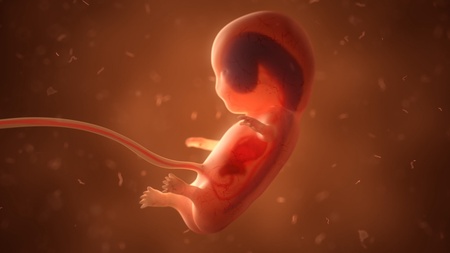Scientists have identified for the first time the details of an 'alternative' biological process required to develop male genitals in an unborn baby.
The findings by researchers at the universities of Aberdeen and Glasgow along with French* and Swedish** collaborators also sheds more light on the reasons for babies being born with undescended testes or with malformed penises.
Studies in the 1950s established that testosterone, produced by the testes in male foetuses is responsible for creating male genitalia through its conversion into a hormone, a “super-testosterone” called DHT.
However, more recently, scientists have discovered that a second additional ‘backdoor’ process also plays a role in creating DHT and thus developing the penis and testes.
It is now known that both these processes must occur successfully to ensure male genitalia develops normally.
This new study, published today in PLOS Biology, shows for the first time that the placenta and adrenal gland also play a key role in creating DHT.
The new information clarifies unusual aspects of human masculinisation and will inform future research looking for ways to identify and treat babies born with sexual development disorders.
Dr Michelle Bellingham of the University of Glasgow explained: “It turns out that there are two ways to make the male signal, DHT. The first is via testosterone from the testes. The second is via a different set of hormones made by other organs, including the foetus’s adrenal gland and the placenta. Importantly, in humans both routes to DHT have to be working properly to make a boy foetus into a boy baby. We know that baby boys whose placentas malfunction are much more likely to be born with undescended testes or with malformed penises. Now we think we know why.”
Professor Paul Fowler, from the University of Aberdeen, added: “The conversion of hormones created by both the testes and the placenta into the super-testosterone DHT in “target” organs like the penis is vital to stimulate development of male sexual characteristics in the womb. For instance, normally the penis is fully formed early in the second trimester – it just gets bigger during adolescence. What we now know is that the testes alone are not enough to do this in humans and that the hormones made by the placenta are also essential.
Professor Paul Fowler added: “Some people affected by disorders of sexual development, such as incomplete masculinisation and abnormal penis formation, may encounter difficulties as they grow. They can also face difficult surgery and long-term hormone therapy. Every new piece of information into how masculinisation happens helps us to understand how to detect and treat these conditions.”
* UMR Oniris-INRA LABERCA, Nantes (Bruno Le Bizec, Jean Philippe Antignac, Marie-Line Morvan)
** Karolinska Institute and University Hospital, Stockholm (Konstantin Svecvhnikov, Olle Söder, Iuliia Savchuk)


